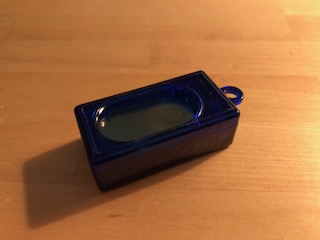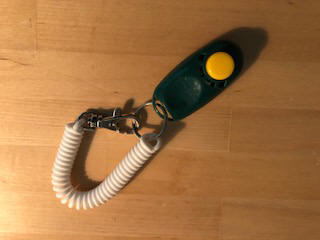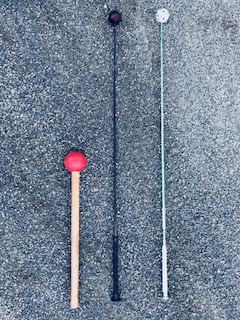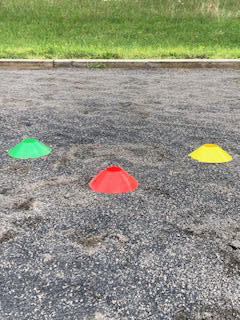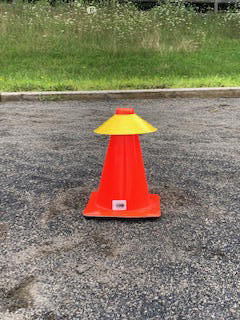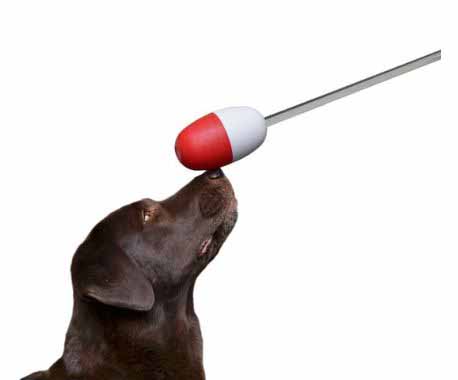|
EQUINE CLICKER TRAINING..... using precision and positive reinforcement to teach horses and people |
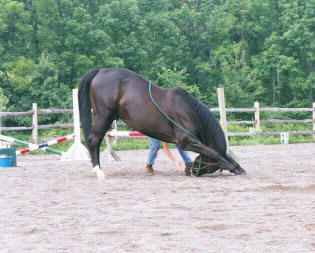
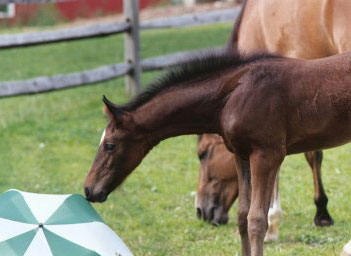
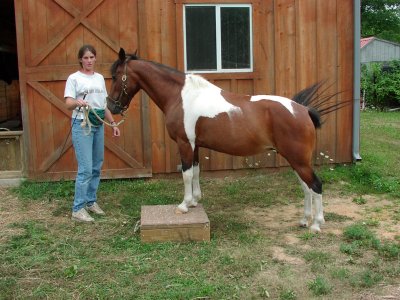
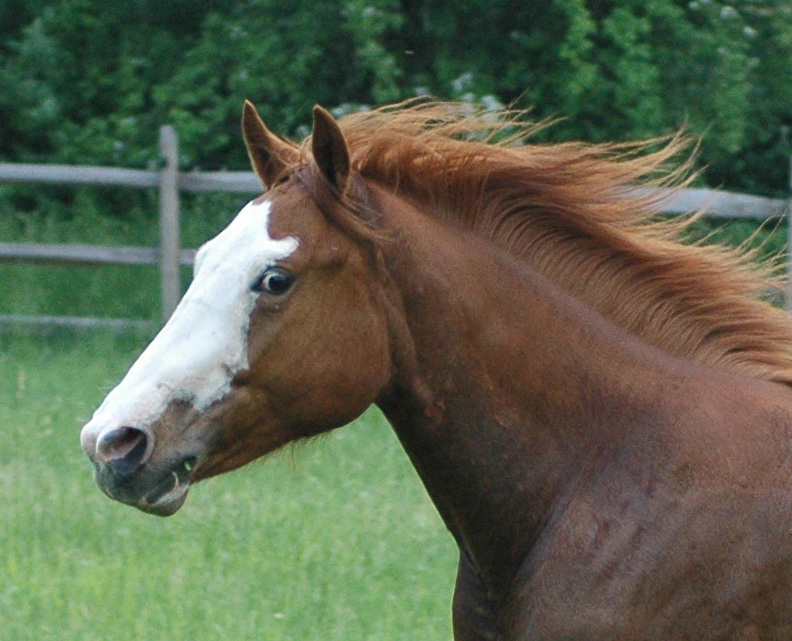
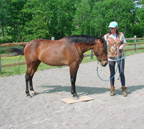
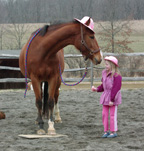
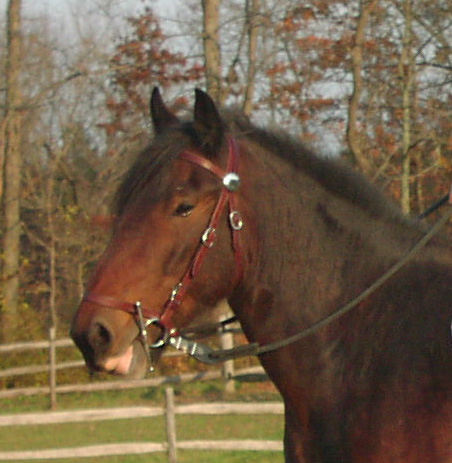
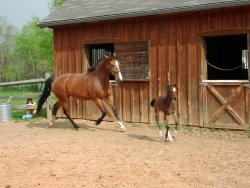 |
|
This page is under development. I will be adding pictures, videos,
and supplemental material as I have time. If you have a question about the
book, please contact me at
kabart315@gmail.com
Chapter 1: What is Clicker Training?
Recommended reading/viewing:
These are in addition to the references included in the book.
Lads Before the Wind by Karen Pryor: If you want to learn more about the early days of applied operant conditioning as used in animal training (outside the lab), this is a great book. Karen is an excellent writer who is knowledgeable, interesting, and easy to read.
Reaching the Animal Mind by Karen Pryor: This book was published in 2009 and takes a broader look at what we have learned about clicker training, how animals learn, and other advances in positive reinforcement training since the early days of clicker training. The book has its own website: http://reachingtheanimalmind.com/
Clicker training and TAGteach: This article in the online magazine, "The Horse" describes one of the newer applications of TAGteach (clicker training for people), which is teaching surgeons how to use surgical tools. Sharing information about how the principles of clicker training can be applied across all species can be a good way to encourage people to give clicker training a try. You can find the article at: https://thehorse.com/159125/if-your-surgeon-was-clicker-trained-why-not-your-horse/
Karen Pryor at ABA: The Art and Science of Animal Training has made available the speech that Karen Pryor gave at the Association of Behavior Analysis International Convention in 1992. The speech is titled “If I Could Talk to the Animals: Reinforcement Interactions as Communication” and offers a glimpse into what behavior analysis was like in the early 1990's. A lot of the points that Karen raises are still important today, and you may find that some of them are useful when you are trying to explain why you choose to train with positive reinforcement.
What can you do with clicker training? Here are some of the more unusual applications
Train a guide horse for the blind: Ann Edie, a student of Alexandra Kurland, is legally blind. When her old guide dog retired and she had difficulty finding a new one, she and Alex decided to train a miniature horse to be her guide. Alex has chronicled the training on her website www.theclickercenter.com.
Using clicker training for conservation: At the Art and Science of Animal Training Conference in 2016, Ken Ramirez shared notes on some of the more unusual projects he has participated in. Topics included re-introducing wild animals, managing exotic animal populations, and using clicker training for management and husbandry with exotic species.
Chapter 2: Clicks, Treats, and What's in Between
Types of clickers
Standard "box" clicker
Karen Pryor "i-click"
Karen Pryor i-click on wrist coil
Recommended reading/viewing:
Dr. Kellon's blog on safe treats for horses: https://drkhorsesense.wordpress.com/2018/10/14/treats/
Chapter 3: A Little Bit of Science
Recommended reading/viewing:
Behavior Analysis for Effective Teaching by Julie Vargas: This book's focus is on teaching human students but much of the content applies to teaching any species. If you are teaching other poeple to train, then you have to learn how to teach both types of students (human and horse) and this book contains some good information.
Eileen Anderson's blog on 1:1 Pairing (1 click = 1 reinforcer): https://eileenanddogs.com/2018/10/31/1-1-pairing-click-treat/
Memory in Horses: https://practicalhorsemanmag.com/health-archive/equine-memory?fbclid=IwAR3sJtwajlizTgIsBFRbjAM41-uP0HzFmD-jW5LQjphDFuK8f0xepSzP5-I
Chapter 4: Training Strategies
Chapter 5: Training Sessions
Chapter 6: Targeting Types of targets:
You can also combine disc cones and target sticks with traffic cones, as shown below.
Marine buoys on dowels are another popular option (www.clickertraining.com):
Examples of targeting as part of husbandry and medical behaviors:
Buster learns to use an inhaler Tooth inspection blog with video link
Chapter 7: A Relaxed Stand
Chapter 8: Head Lowering
Chapter 9: Mat Work
4 feet on a box (raised mat)
2 feet on a mat
Notes:
CHAPTER 1: WHAT IS CLICKER TRAINING?
Dani Weinberg quote:
Weinberg, Dani. 2006.
Teaching People Teaching Dogs. (New York:
Howln Moon Press), 27.
Dani Weinberg’s website:
http://home.earthlink.net/~hardpretzel/DaniDogPage.html
The Butterfly Project:
https://www.clickertraining.com/the-butterfly-project Training Pouched Rats to Detect Landmines: https://news.nationalgeographic.com/2015/10/151006-giant-rats-landmines-cambodia-science-animals/
ClickerExpo:
www.clickerexpo.com
Karen Pryor clicker training:
www.clickertraining.com
Art and Science of Animal Training Conference:
http://www.artandscienceofanimaltraining.org/conference/
Suggested resources on reading body language in
horses:
Many resources are available on this subject but do be aware that they are based
on the author’s interpretation. Here are a few that I have found useful, as they
describe the types of body language that we need to learn to observe.
Bennet, Deb, Ph.D.
2000. The
Birdie Book: An Internal Geography of Rider and Horse. This is available on
her website
www.equinestudies.org as a
CD-ROM. It has lots of pictures and descriptions of horse body language.
Draaisma, Rachael.
2018. Language
Signs and Calming Signals of Horses: Recognition and Application. (Boca
Raton, Florida: Taylor and Francis Group, LLC).
McDonnell, Sue, PhD. 2003. A
Practical Field Guide to Equine Behavior: The Equid Ethogram. (Lexington,
Kentucky: The Blood-Horse, Inc).
Are we Trainers, or
Teachers?
Kay Laurence:
www.learningaboutdogs.com
Alexandra Kurland (The Click that Teaches):
www.theclickercenter.com
Connection Training:
http://www.connectiontraining.com/
Alexandra Kurland’s blog:
www.theclickercenterblog.com
Claudeen McAuliffe quote: McAuliffe, Claudeen E. 2006.
Mindful Dog Training. (Oconomowoc, Wisconsin: Kindness Canine
Behavior Consultants LLC), 1. This book is available from
www.dogwise.com.
Kurland, Alexandra. Notes from the 2013 Equine Clicker Conference,
included with her permission.
Why Do I Clicker Train?
Kathy Sdao’s website:
www.kathysdao.com
Kathy Sdao quote: Sdao, Kathy. 2012. Plenty in Life
is Free. (Wenatchee, Washington: Dogwise), 81-82.
CHAPTER
2: CLICKS, TREATS, AND WHAT HAPPENS IN BETWEEN
Dr. Kellon’s website:
www.drkellon.com
ECIR website:
www.ecirhorse.org
Learning About the
Clicker
The clicker as a marker signal:
Pryor, Karen. 2009.
Reaching the Animal Mind. (New York:
Scribner). 83.
More information on marker signals: https://equineclickertraining.wordpress.com/2017/02/16/marker-signals-thinking-beyond-the-click/
Jenifer Zeligs’ website:
https://animaltraining.us/about-2/
Jenifer Zeligs quote:
Zeligs, Jenifer. 2014.
Animal Training 101. (Minneapolis,
Minnesota: Millcity Press). 55.
Research on click vs. voice:
Wood, Lindsey. 2008. Her Master’s
Thesis on Teaching Shelter Dogs with a clicker vs. voice makers. You can read
about it at:
http://www.clickertraining.com/node/1960.
blog post on marker signals:
https://equineclickertraining.wordpress.com/2017/02/16/marker-signals-thinking-beyond-the-click/
i-Click:
https://www.clickertraining.com/node/4397
The Basics of Food
Delivery
Alexandra Kurland’s blog showing backing for food
delivery:
https://theclickercenterblog.com/2015/11/20/
Website article on strategic food delivery:
http://www.equineclickertraining.com/articles/food_delivery.html Website article on food delivery for riding: http://www.equineclickertraining.com/articles/getting_started_riding.html
Mugging
Blog post on chains:
https://equineclickertraining.wordpress.com/2015/09/28/fetch-a-fun-game-and-an-introduction-to-behavior-chains/
Reference to Dr. Susan Friedman’s Living and
Learning with Animals Course. Offered through
www.behaviorworks.org every
fall.
Motivation
Definition of motivation:
www.oxford
dictionaries.com Friedman, Susan. 2010. “P-A-R-R-O-T do Tell, Best Practices for Teaching Animals” PsittaScene August 2010. 14-17. (Information on constructs) - https://tinyurl.com/yd9a3apl
Barbara Heidenreich:
www.goodbirdinc.com
Barbara Heidenreich paper:
“The Ethics of Animal Training and Handling.” 2008.
Presented at The International Association of Avian Trainers and Educators
Conference: Alphen aan den Rijn, The Netherlands, March 5–8, 2008.
Timing
SMART x 50:
Sdao, Kathy. 2012.
Plenty in Life is Free. (Wenatchee, Washington: Dogwise), 48-64.
Loopy Training:
Kurland, Alexandra. 2011. Loopy
Training. (DVD) The Clicker Center LLC.
Website article on
loopy training:
http://www.equineclickertraining.com/articles/loopy_training_new.html
CHAPTER 3: A LITTLE BIT OF SCIENCE
Operant Conditioning
B.F. Skinner biographical information: Vargas, Julie. 2009.
Behavior Analysis for Effective Teaching. (New York, New York:
Routledge). 7-8.
Definition of operant conditioning: Chance,
Paul. 2003. Learning and Behavior, 5th edition. (Belmont, Ca:
Wadsworth/Thompson Learning). 138.
Definition of a stimulus: Chance,
Paul. 2003. Learning and Behavior, 5th edition. (Belmont, Ca:
Wadsworth/Thompson Learning). 454.
Poisoned cues:
The best source for more information on this is Alexandra
Kurland’s DVD “The Poisoned Cue,” available on her website,
www.theclickercenter.com. If you want to read the
original study, you can find it on the ORCA website, under
The Effects of
Combining Negative and Positive Reinforcement.
For
more information on operant conditioning, I recommend finding a used copy of a
textbook. The one I use the most is Paul Chance’s
Learning and Behavior, but I’ve seen some others that contain
similar information. Books on Behavior Analysis can also be helpful, but they
tend to contain more jargon.
Dr. Jesús Rosales-Ruiz bio:
https://orgs.unt.edu/orca/bio/dr-jesus-rosales-ruiz/
Organization for Reinforcement
Contingencies for Animals (ORCA):
http://orgs.unt.edu/orca/
ClickerExpo notes on Dr. Jesus
Rosales-Ruiz’s talk on the quadrants:
https://equineclickertraining.wordpress.com/2016/04/02/notes-from-clickerexpo-dr-jesus-rosales-ruiz-the-quadrant-quandry-clarity-and-perspective-on-an-icon/
Karen Pryor on extinction (notes
from ClickerExpo):
http://www.equineclickertraining.com/articles/clickerexpo2014_new.html#Pryor
Jesús Rosales-Ruiz on resurgence
(notes from ClickerExpo):
http://www.equineclickertraining.com/articles/clickerexpo2014_new.html#Rosales-Ruiz
Two
books that I recommend are Karen Pryor’s
Don’t Shoot the Dog, and Pamela Reid’s
Excel-erated Learning. Both books were written for the general public and
are easy to read. They may contain some different terminology than that used by
professionals in the fields of psychology and behavior analysis, but the
material is clear and well presented.
Punishment
Bob Bailey’s website:
www.behavior1.com
Susan Friedman quote: Friedman, Susan. 2010.
APDT Journal March/April 2010. You can
read it here:
http://behaviorworks.org/files/articles/APDT%20What's%20Wrong%20with%20this%20Picture%20-%20Dogs.pdf
Steve White quote:
White, Steve. Trainer’s Pocket
Reference. Shared with permission from Steve White.
Steve White’s website:
www.proactivek9.com
Karen Pryor quote:
Pryor, Karen. 2009.
Reaching the Animal Mind. (New York:
Scribner). 14.
Brené Brown quote:
Brown, Brené. 2012.Daring
Greatly. (New York: Penguin (Gotham), 184.
Classical Conditioning
Definition of a stimulus: Chance, Paul. 2003.
Learning and Behavior, 5th
edition. (Belmont, Ca: Wadsworth/Thompson Learning). 454.
Definition of classical
conditioning:
Cooper, John O., Heron, Timothy E., and Heward, William L. 2014.
Applied Behavior Analysis, 2nd
edition. (Essex, UK: Pearson Education Limited). 15.
Classical conditioning is not
just for reflexes:
2018. Private discussion with Dr. Joe Layng and Dr. Rosales-Ruiz.
Discussion of types of classical
conditioning:
Chance, Paul. 2003. Learning and Behavior,
5th edition. (Belmont, Ca: Wadsworth/Thompson Learning). 79-80.
Notes on how to use classical
conditioning:
Sdao, Kathy. 2014. Lecture at Clicker Expo. My original notes are available at
http://www.equineclickertraining.com/articles/clickerexpo2014_new.html
Definition of desensitization: Cooper, John O., Heron, Timothy
E., and Heward, William L. 2014. Applied
Behavior Analysis, 2nd edition. (Essex, UK: Pearson Education
Limited). 17.
Definition of flooding: McGreevy, P.D. and Boakes, R.A.
Carrots and Sticks: Principles of Animal
Training. 2007. (New York, NY: Cambridge University Press). 287.
Reference to exposure
therapy:
Boudewyns, Patrick A. and Shipley, Robert H.
Flooding and Implosive Therapy in Clinical
Practice. 1983.
(New York, NY: Springer Science
and Business).
Definition of habituation: Ramirez, Ken. 1999.
Animal Training. (Chicago, Illinois:
Shedd Aquarium). 542.
Reinforcement
Definition of reinforcement: Chance, Paul. 2003.
Learning and Behavior, 5th
edition. (Belmont, Ca: Wadsworth/Thompson Learning). 454.
Definitions of types of
reinforcers:
Chance, Paul. 2003. Learning and Behavior,
5th edition. (Belmont, Ca: Wadsworth/Thompson Learning). 453-454.
Research on different
reinforcers:
LeBlanc, Michel-Antoine. 2013.
The Mind of the Horse. (Cambridge, Mass: Harvard University Press). 5 quotes –
locations are 5639-40, 5734, 5766, 5782, 5797 (kindle locations on e-book).
Leslie McDevitt quote: McDevitt, Leslie. 2007.
Control Unleashed. (South Hadley,
Mass: Clean Run Productions LLC).
211.
Kay Laurence quote: Laurence, Kay. 2013.
Clicker Revolution. (Chipping Camden,
UK: Learning About Dogs Limited). 92.
The Click as a
Conditioned Reinforcer
Blog on marker signals:
https://equineclickertraining.wordpress.com/2017/02/16/marker-signals-thinking-beyond-the-click/
Research on the effect of
treating after every other click:
On the effect of clicking multiple times before reinforcing:
Blog on conditioned reinforcers (ASAT 2017 notes):
https://equineclickertraining.wordpress.com/2017/03/24/notes-from-the-art-and-science-of-animal-training-conference-orca-dr-jesus-rosales-ruiz-on-conditioned-reinforcers-are-worth-maintaining/
How Neuroscience Can Help
Us with Training
Dr. Jaak Panksepp on the seven
systems:
TED talk by Dr.
Panksepp:
https://www.youtube.com/watch?v=65e2qScV_K8
Karen Pryor on the SEEKING system:
Reinforcement and Bribery
Susan Friedman quote: Friedman, Susan. 2005. ‘He
said, She said, Science Says.” Good Bird Magazine Volume 1-1, Spring 2005.
You can read it here:
http://www.behaviorworks.org/files/articles/He%20Said,%20She%20Said,%20Science%20Says.pdf
Karen Pryor quote: Pryor, Karen. 2009.
Reaching the Animal Mind. (New York:
Scribner). 144.
CHAPTER 4: TRAINING STRATEGIES
Rules of stimulus
control: Pryor, Karen. 1999. Don’t
Shoot the Dog. (New York: Bantam). 73.
Blog post on cues:
https://equineclickertraining.wordpress.com/2016/02/05/do-you-have-a-cue-for-that/
Targeting
Touching the Goblins:
Kurland, Alexandra. 2003. The Click That
Teaches: A Step-by-Step Guide in Pictures. (Delmar, NY: The Clicker Center
LLC). 118.
Blog post “Aurora gets
a bath:”
https://equineclickertraining.wordpress.com/2016/06/14/aurora-gets-a-bath-some-tips-on-how-to-train-your-horse-for-husbandry-behaviors/
Blog post “Tooth
Inspection:”
https://equineclickertraining.wordpress.com/2017/10/20/teaching-husbandry-behaviors-with-clicker-training-tooth-inspection/
Blog post on body part
targeting:
https://equineclickertraining.wordpress.com/2015/10/28/body-part-targeting-moving-beyond-nose-targeting/
Blog post on using
targets to ride out:
https://equineclickertraining.wordpress.com/2016/10/04/using-targeting-to-build-confidence-when-riding-outside-the-ring/
Luring
Notes on luring:
Laurence, Kay. 2015.
Intelligent Dog Trainers Course. On-line course where I learned the finer
details of luring. Kay teaches a variety of courses and you can find them listed
on her website,
www.learningaboutdogs.com.
Going operant: Laurence, Kay. 2013.
Clicker Revolution. (Chipping Camden,
UK: Learning About Dogs Limited). 110.
Shaping
Micro-shaping:
Laurence, Kay. 2013.
Clicker Revolution. (Chipping Camden,
UK: Learning About Dogs Limited). 55.
Blog on micro-shaping:
https://equineclickertraining.wordpress.com/2016/03/02/notes-from-the-art-and-science-of-animal-training-conference-orca-kay-laurence-on-micro-shaping/
Choosing Your
Training Strategy
Self-directed and directed
learning:
Laurence, Kay. 2013. Clicker Revolution.
(Chipping Camden, UK: Learning About Dogs Limited). 44-50.
A Closer Look at the Process of Shaping
10 Laws
of Shaping: Pryor, Karen. 1999.
Don’t Shoot the Dog. (New York:
Bantam). 40.
A Shaping Plan
to Teach Whales to Blow Bubble Rings
Ramirez, Ken. 2015.
Presentation on Shaping Beluga Whales to Blow Bubbles. Art and
Science of Animal Training Conference. Denton, Texas. Unpublished, article is
based on personal notes, shared with Ken Ramirez’s permission.
CHAPTER 5: TRAINING SESSIONS
Reinforcement schedules:
Chance, Paul. 2003. Learning and Behavior,
5th edition. (Belmont, Ca: Wadsworth/Thompson Learning). 347-355.
ClickerExpo notes on reinforcement substitutes:
http://www.equineclickertraining.com/articles/clickerexpo2008_new.html
ClickerExpo notes on chains:
http://www.equineclickertraining.com/articles/clickerexpo2011_new.html
How to Introduce Your Horse to Clicker Training
Website
article “Taking Clicker Training from the Classroom to Real Life:”
http://www.equineclickertraining.com/articles/classroom_to_real_life.html
What Behaviors Should You Train First?
Foundation behaviors:
Kurland, Alexandra. 2005.
The Click That Teaches: Riding with the Clicker. (Delmar, NY: The
Clicker Center LLC). 13-14.
CHAPTER 6: TARGETING
An Introduction
to Targeting
Reference to Kay
Laurence’s Intelligent Dog Training Course, offered by Kay Laurence from 2015-2017.
For more information on Kay’s courses, visit
www.learningaboutdogs.com
Adding a New
Cue to the Behavior “Touch the Target”
Stimulus
control: Pryor, Karen. 1999.
Don’t Shoot the Dog. (New York:
Bantam). 73.
Building Duration: Waiting at a Target
Blog on
body part targeting:
https://equineclickertraining.wordpress.com/2015/10/28/body-part-targeting-moving-beyond-nose-targeting/
Website
article on duration:
http://www.equineclickertraining.com/articles/duration_new.html
CHAPTER 7: A RELAXED STAND
Grown-ups:
Kurland, Alexandra. 2003. The Click that
Teaches, A Step by Step Guide in Pictures. (Delmar, NY:
The ClickerCenter, LLC). 31.
CHAPTER 8: HEAD LOWERING I learned head lowering from Alexandra Kurland and the information in this chapter is based on a combination of her work and my own experience. If you would like more information on how Alexandra Kurland teaches head lowering, you can find additional resources on her website, www.theclickercenter.com.
Head lowering: Kurland, Alexandra. 2006.The Click that
Teaches Lesson 3: Head lowering: Your Calm-Down Cue (DVD). (Delmar, NY:
TheClickerCenter LLC).
Head Lowering: Adding Cues, Duration and Movement
Backing in a square
exercise:
Kurland, Alexandra. 2005.
The Click that
Teaches, Riding with the Clicker. (Delmar, NY: TheClickerCenter LLC). 38-39.
CHAPTER 9: MAT WORK
Alexandra Kurland’s
approach to mat work:
Kurland, Alexandra. 2003. The Click that
Teaches, A Step by Step Guide in Pictures. (Delmar, NY:
The ClickerCenter, LLC). Kurland, Alexandra. 33-35.
A Training Plan
for Mat work
Margaret’s mind map for
mat work:
http://www.equineclickertraining.com/articles/matdiagram_new.html
More Advanced
Mat work
Blog on using a mat as
the terminal behavior in a chain:
https://equineclickertraining.wordpress.com/2016/10/21/a-training-strategy-for-building-duration-backchain-it-by-using-a-terminal-behavior/
CHAPTER 10: BACKING
Alexandra Kurland’s
approach to backing:
Kurland, Alexandra. 2003. The Click that
Teaches, A Step by Step Guide in Pictures. (Delmar, NY:
The ClickerCenter, LLC). Kurland, Alexandra. 88-92.
Cues as information:
Pryor, Karen. On My Mind. 2014.
(Waltham, Mass: Sunshine Books). Location 2489 (e-book).2489.
CHAPTER 11: OTHER FIRST BEHAVIORS
Can I Touch
You?
Blog on body part
targeting:
https://equineclickertraining.wordpress.com/2015/10/28/body-part-targeting-moving-beyond-nose-targeting/
Walking Forward
Blog on using cones,
mats and poles:
https://equineclickertraining.wordpress.com/2017/10/29/cones-mats-and-targets-putting-them-to-use-in-ground-and-ridden-work-to-teach-new-behaviors-and-facilitate-learning/
Happy Faces
Description of Happy
Faces:
Kurland, Alexandra. 2003. The Click that
Teaches, A Step by Step Guide in Pictures. (Delmar, NY:
The ClickerCenter, LLC). Kurland, Alexandra. 36.
A Balanced Halt
Pre-WWYLM game:
Kurland, Alexandra. Private instruction.
CHAPTER 12: LOOKING FORWARD
Alexandra Horowitz quote: Horowitz, Alexandra. 2009.
Inside of a Dog. (New York: Scribner).
280.
Alexandra Horowitz’s author page: http://www.simonandschuster.com/authors/Alexandra-Horowitz/46971319
Find Your Troop
Steve Peters quote: Peters, Steve. 2011.
The Chimp Paradox. (New York: Jeremy
P. Tarcher/Penguin). 172
Steve Peters quote: Peters, Steve. 2011.
The Chimp Paradox. (New York: Jeremy
P. Tarcher/Penguin). 178
Steve Peters’ author page:
https://www.penguin.co.uk/authors/prof-steve-peters/1065654/
Educational opportunities page on
my website:
http://www.equineclickertraining.com/community/educational_opportunities.html
Making
Decisions
Malcolm Gladwell’s author page:
https://www.littlebrown.com/?s=malcolm+gladwell
Daniel Kahneman quote: Kahneman, Daniel. 2011.
Thinking Fast and Slow. (New York:
Farrar, Straus and Giroux). 21-34.
Daniel Kahneman quote: Kahneman, Daniel. 2011.
Thinking Fast and Slow. (New York:
Farrar, Straus and Giroux). 286.
Daniel Kahneman’s author page:
http://us.macmillan.com/books/9780374533557
Advances in the
Use of Positive Reinforcement in Animal Training
Susan Friedman quotes: Friedman, Susan. 2008.
Avian Behavior:
An Evolving Discipline. Journal of Avian Medicine and Surgery. 66-72.
You can read the article at
http://www.behaviorworks.org/files/journals/JAMS%20Round%20Table%20Discussion.pdf
|
|||||||
